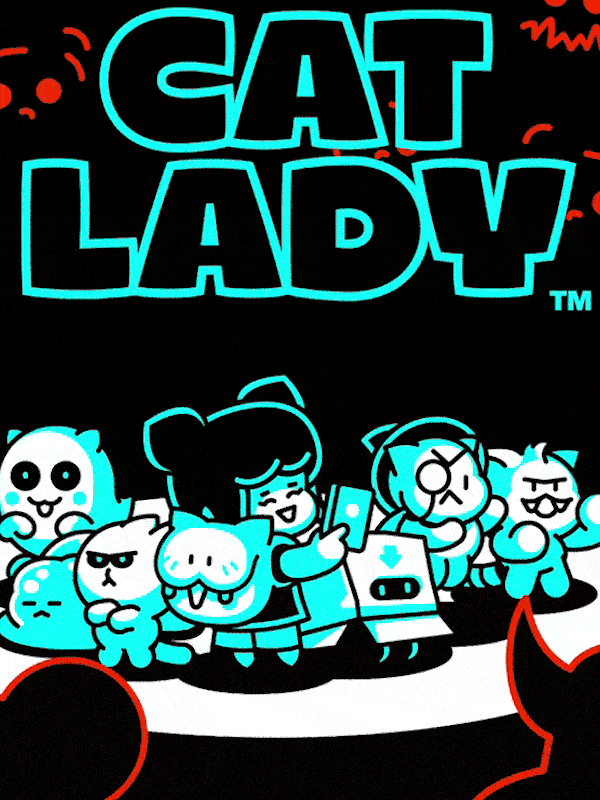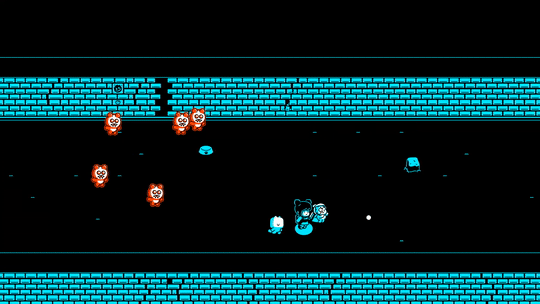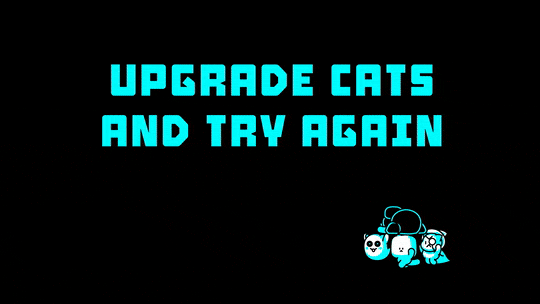A blog dedicated to analyze, discuss and dissect the design of tabletop games utilizing the design theory applied to modern video games.
Don't wanna be here? Send us removal request.
Photo
Hey. I made this. I work here. I made it.

Indie Game Spotlight: Cat Lady
Get ready to live your ultimate cat lady dreams this week with our latest Indie Game Spotlight. Cat Lady is an action roguelike game where Ally, our cat-loving hero, goes for a nice visit to Grandma’s mansion… only to find that it’s haunted! Grandma’s many cats gain magical abilities and team up with Ally to pound and paw perilous poltergeists in the ever-growing mansion—featuring a cute art style, cats that need rescuing, and tons of upgrades for your weaponized kitties.
We chatted with Will Lewis, co-founder of Rose City Games and director of the game, its artist and animator Jake Fleming, programmer Nic Biondi, and designer Christian Scandariato. Read on!

Which games or movies inspired Cat Lady?
Will: My head jumps around a lot when I think about the inspiration behind Cat Lady. I grew up playing a lot of dungeon crawlers and was always a fan of exploring creepy and dark medieval settings, but never really played roguelikes. Playing a lot of interactive fiction adventures like Dark Castle and King’s Bounty on Mac, or newer indie games like Bernband over the years really kept those interests in my head. After watching the funny, over-the-top scene in Invader Zim in which Dib gets lost in the mall’s parking garage, I started working on an interactive fiction where you needed to find your cat in a series of weird dark places, and I think that was the only thing I ever wrote down that linked cute cats with creepy mansions. This was years before the release of Cat Lady’s gameplay inspirations like Nuclear Throne and Binding of Isaac, but Jake and I explored the general style of something that might come from my original idea and things just kind of came together from there! It’s also been super fun to work with Jake’s character design style to mesh that cute and creepy vibe—he definitely comes up with awesome stuff that I would never think of.
Jake: I’ve always been a fan of limited color palettes, which probably stems from playing a lot of games on NES and Gameboy growing up. With Nintendo being the console I ended up having as a kid, I got very accustomed to cute and quirky characters like the cast of Kirby or even River City Ransom. I remember seeing a Boo for the first time in Super Mario Bros 3, and thinking it was simultaneously adorable and terrifying. From a conceptual perspective, the NES game Stinger had a very profound influence on me in terms of enemies in Cat Lady: There are some very fun and weird inanimate objects that, for some reason, are alive and trying to kill you!

The original concept for Cat Lady was created at a game design jam in 2017. How much has changed from then to now?
Will: Cat Lady has changed a whole lot since then, but thankfully not too much! The art has certainly changed: cats were originally tiny, with tiny eyes and little to no expression. We had a lot more facial details on ghosts, even more so than the main character, Ally. We learned from The World Next Door that people loved the archetypes and being able to level-up their characters, sometimes even more than using them in some cases, so you’ll now see numerous cats with very different facial and body details which gives them much more personality.
We also made a big change in gameplay: Ally used to have a flashlight, which she used to reveal ghosts and mark objects in the environment as safe. Once cats started shooting fireballs and punching everything, we thought there’s probably no need to shine a light on a box if you’ve blown it up with magic, and removed the flashlight mechanism.

What has been the team’s favorite thing to create in the game?
Will: Personally, I really really like writing the backstory and lore. Cat Lady is a way more combat-focused game, but there’s still a reason for why everything exists in the way it does!
Jake: The visual vibe! The relationship between cute, creepy, and weird is something I’m always toying with. I love hearing feedback like, “Oh wow. That is adorable…and gross!” It can get kinda boring if everything is nothing but cute. Take Kirby for example. I think everyone can agree that Kirby is a pink squishy little ball of cuteness. HE ALSO SWALLOWS HIS ENEMIES WHOLE AND CONSUMES THEIR POWER. Cute and weird.
Christian: Levels! Creating the bulk of the content is always a good time. Also Puddles the blobby, watery cat. Puddles is my favorite.
Nic: Cat Lady has been a dream to work on, so it’s hard to pick just one thing as my favorite. If I had to pick something, I think it would probably be the level editor and content tools. I enjoy making systems, and it’s been really fun to see the awesome cats, enemies, items, and levels the team has created using those tools.

If you could have any famous cat appear in the game, who would it be and why?
Will: I would want Scuba to be in the game because she’s the cutest. Or any famous sneezing cat. Or a British Shorthair but that’s not necessarily a famous cat.
Jake: I know this isn’t a real cat, but it’d have to be Garfield. That dude loves lasagna.
Nic: Oh, that’s a hard one! It would either be Keyboard Cat or Grumpy Cat. Grumpy Cat would be rocking a suit and wielding a powerful gavel celebrating her successful “Grumppuccino” litigation. Keyboard Cat would, of course, be driving a motorized baby grand piano around and flattening all who stand in his way.
Ready to get your paws on Cat Lady? You will, of course, be able to purchase it on Steam, where you can also wishlist the game to keep track of announcements like the release date. And their website has a newsletter you can sign up to that will keep you up to date on additional announcements!
1K notes
·
View notes
Conversation
Player: I don't like my character.
Me: Why?
Player: I don't know what I'm doing with him.
Player: All of my stats are wrong.
Player: I took all the wrong skills.
Player: I have no motivations.
Player: My backstory makes no sense.
Player: My character sheet is a swirling vortex of entropy.
Me: Do you want to roll a new character?
Player: Hell no. What are you thinking?
241 notes
·
View notes
Note
Quick question about the miracle elixir: when do I get my sight back?
Who needs sight when you have solid prep, right? Right?...Consult a physician.
4 notes
·
View notes
Text
Prep Tip #51 - Miracle Elixir
Hi folks! CorruptionPoints here, with another real deal no jokes prep tip.
It is important to not only feed the mind, but to also feed the body when establishing prep for a session. For example, I have a simple concoction that always gets me in the mood for prep, which I would love to share with you all.
I call it “The Miracle Elixir”. Check it out under the break!
Keep reading
100 notes
·
View notes
Photo

Tonight's Game: Dungeons & Dragons 5th Edition!
43 notes
·
View notes
Photo

Goodbye, Scylla Redhand! First death of the campaig, caught between a bomb and a hard place.
25 notes
·
View notes
Text
How I Prioritize Game Prep
“Okay, which of these things can I absolutely not just make up as I go along?”
2K notes
·
View notes
Note
I tried playing Shadowrun once with a DM that read over the gun rules because they didn't like the way the rulebook was set up and ignored everything else, particularly magic. It was a shame because I really loved the setting and the character I made, who was all mage and no gun and was basically worthless. How good would you say the rulebooks are?
They’re manageable.
There are certainly more dense rulebooks and more arcane systems to play. With a little time and some concentration, any person could absolutely wrap their mind around Shadowrun as a whole, which can be said about (generally) any game.
Regardless of the system, a GM should never whole-sale disregard a major part of the game, especially if there are players who have actively taken the role of the parts they’re ignoring. I’m sorry you were put in that situation, anon!
123 notes
·
View notes
Note
I agree!
Part of the reason why I enjoy Shadowrun so much is the combination of magic and cyberpunk elements, with the opportunity to fully explore either or both in any given campaign. This sprawling, kitchen sink aspect is the same reason I’m drawn to Exalted.
But, of course, to each their own.
I tried playing Shadowrun once with a DM that read over the gun rules because they didn't like the way the rulebook was set up and ignored everything else, particularly magic. It was a shame because I really loved the setting and the character I made, who was all mage and no gun and was basically worthless. How good would you say the rulebooks are?
They’re manageable.
There are certainly more dense rulebooks and more arcane systems to play. With a little time and some concentration, any person could absolutely wrap their mind around Shadowrun as a whole, which can be said about (generally) any game.
Regardless of the system, a GM should never whole-sale disregard a major part of the game, especially if there are players who have actively taken the role of the parts they’re ignoring. I’m sorry you were put in that situation, anon!
123 notes
·
View notes
Note
I once read of challenge to design a rpg that based on dice, I've thought of a new challenge; design a game around a mechanic you hate. My understanding is that you are not a fan of alignment so you would have to design one you like use it as the heart of your system. (I don't like exploding dice so that is what I've been looking at.)
It’s true, I think alignment is dumb and useless. Let me take a minute to explain, and then I’ll dive into what I believe to be a rather good design challenge.
When I play games, I try to disregard alignment entirely. If a player would like to refer to the alignment table as they create their character(s) in order to get a better sense of their character(s), I am 100% behind it and will do my best to explain the alignments as they stand.
The issue that I have with alignment is that real life doesn’t fit into a 3x3 grid, and not every action can be mapped to a square. It also results in being restrictive rather than informative, where players either take actions to suit their alignment or spend unnecessary time explaining how “X” action fits “Y” alignment.
Onto the challenge!
If I were creating a system with alignment at the heart, taking into account what I outlined above, I’d create the following core mechanic.Each player chooses one section of the alignment grid at the start of the game. After each player has chosen one, each player then selects a second section of the alignment grid and assigns it to another player.
Once each player has selected one section and been assigned a second, the players must create a backstory for their character, detailing a beginning, middle, and end point, utilizing the two alignments.
The player chosen alignment and the assigned alignment can be either the beginning or the end, respectively, but both must be utilized within the backstory.
Here’s an Example!I am a player, I have selected Lawful Good as my alignment. Another player has assigned Neutral Evil to me. I can now create a story where my Lawful Good beginnings ended in a final destination of Neutral Evil, or if I cast aside my nefarious Neutral Evil ways and became Lawful Good.
The players would then be able to continue in the fantasy-based system of their choosing, however they have established a character that has progressed through at least two different alignments. As the game is played, their character may change further, revert to their old ways, or become something entirely different.
This would solve the restrictive issues I have with alignment, help players establish their characters with the benefits of alignment, and outline that people and characters grow naturally and organically over time, rather than needing to stay on one box for their whole lives.
124 notes
·
View notes
Note
I once read of challenge to design a rpg that based on dice, I've thought of a new challenge; design a game around a mechanic you hate. My understanding is that you are not a fan of alignment so you would have to design one you like use it as the heart of your system. (I don't like exploding dice so that is what I've been looking at.)
It’s true, I think alignment is dumb and useless. Let me take a minute to explain, and then I’ll dive into what I believe to be a rather good design challenge.
When I play games, I try to disregard alignment entirely. If a player would like to refer to the alignment table as they create their character(s) in order to get a better sense of their character(s), I am 100% behind it and will do my best to explain the alignments as they stand.
The issue that I have with alignment is that real life doesn’t fit into a 3x3 grid, and not every action can be mapped to a square. It also results in being restrictive rather than informative, where players either take actions to suit their alignment or spend unnecessary time explaining how “X” action fits “Y” alignment.
Onto the challenge!
If I were creating a system with alignment at the heart, taking into account what I outlined above, I’d create the following core mechanic.Each player chooses one section of the alignment grid at the start of the game. After each player has chosen one, each player then selects a second section of the alignment grid and assigns it to another player.
Once each player has selected one section and been assigned a second, the players must create a backstory for their character, detailing a beginning, middle, and end point, utilizing the two alignments.
The player chosen alignment and the assigned alignment can be either the beginning or the end, respectively, but both must be utilized within the backstory.
Here’s an Example!I am a player, I have selected Lawful Good as my alignment. Another player has assigned Neutral Evil to me. I can now create a story where my Lawful Good beginnings ended in a final destination of Neutral Evil, or if I cast aside my nefarious Neutral Evil ways and became Lawful Good.
The players would then be able to continue in the fantasy-based system of their choosing, however they have established a character that has progressed through at least two different alignments. As the game is played, their character may change further, revert to their old ways, or become something entirely different.
This would solve the restrictive issues I have with alignment, help players establish their characters with the benefits of alignment, and outline that people and characters grow naturally and organically over time, rather than needing to stay on one box for their whole lives.
#Tabletop#alignment#roleplaying game#Corruptionpoints answers a question!#I realize this isn't a full system#But it's a start that takes less than 5000 words :D#dungeons and dragons#dnd#D&D#Pathfinder
124 notes
·
View notes
Note
Psshh yourself! Tabletop side of Tumblr needs to stick together. This is an “All Friends” zone.

In Tumblrverse, I'm Neutral Good. Favorite hero is Captain America.
Pssht, get outta my ask box. You’re way too cool to be my friend.

29 notes
·
View notes
Note
I tried playing Shadowrun once with a DM that read over the gun rules because they didn't like the way the rulebook was set up and ignored everything else, particularly magic. It was a shame because I really loved the setting and the character I made, who was all mage and no gun and was basically worthless. How good would you say the rulebooks are?
They’re manageable.
There are certainly more dense rulebooks and more arcane systems to play. With a little time and some concentration, any person could absolutely wrap their mind around Shadowrun as a whole, which can be said about (generally) any game.
Regardless of the system, a GM should never whole-sale disregard a major part of the game, especially if there are players who have actively taken the role of the parts they’re ignoring. I’m sorry you were put in that situation, anon!
123 notes
·
View notes
Note
Which edition of Shadowrun do you like most?
This is a good question!I started with 4th Edition, and despite all of its glaring, glaring flaws, it was more than enough to propel me into a never-ending love of the system.
I own every book printed for 5th Edition, despite the fact that I’ve only played it once, and prefer every single rule listed there to the 4th edition counterparts (Matrix notwithstanding, it’ll always make me dizzy.)If I were actively running the game right now, I’d prefer 5th edition. Although, because it’s the lovable mess I started with, I probably prefer 4th edition overall.Although, I literally just bought the first through third editions, so I might need to subject my current players to a mid-90s tech-noir firefight sometime soon.
12 notes
·
View notes








